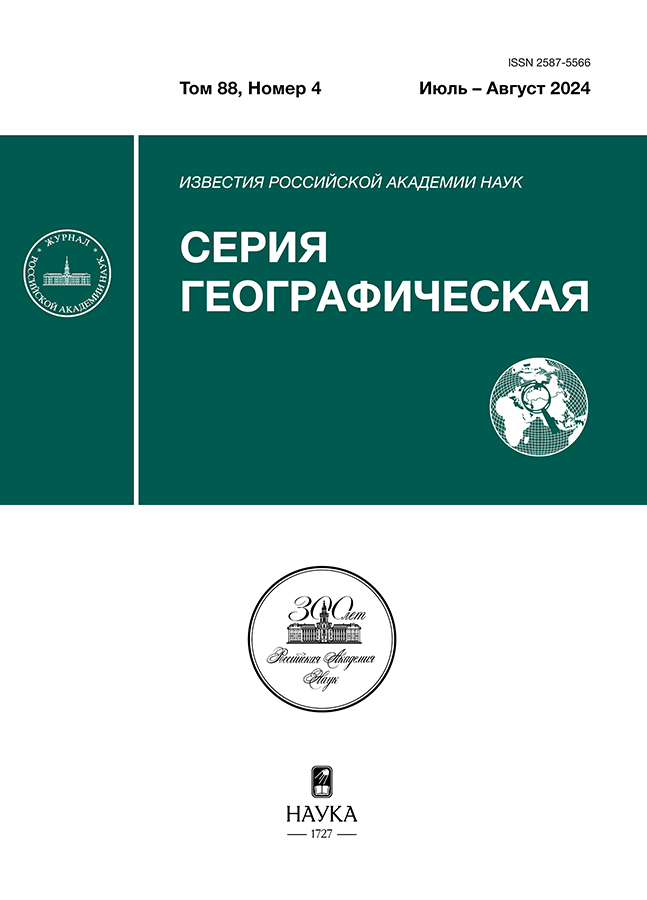Types of Network Behavior of Users of Social Network “VKontakte” in the Cities of Vologda Oblast
- Autores: Sinitsyn N.A.1
-
Afiliações:
- Lomonosov Moscow State University
- Edição: Volume 88, Nº 4 (2024)
- Páginas: 583-596
- Seção: РЕГИОНАЛЬНЫЕ ГЕОГРАФИЧЕСКИЕ ПРОБЛЕМЫ
- URL: https://journals.eco-vector.com/2587-5566/article/view/660855
- DOI: https://doi.org/10.31857/S2587556624040106
- EDN: https://elibrary.ru/RPEKUO
- ID: 660855
Citar
Texto integral
Resumo
This study is based on open data of the social network “VKontakte.” The personal data of users from the cities of Vologda oblast were collected using the “VKontakte” API. Several filters were developed to exclude fake users. Complex characteristics of users were created. It reflects his tastes and interests according to his subscriptions for communities. A group of users who tend to subscribe to a certain set of communities is called a pattern of social network behavior. The patterns were defined using the developed method of graph clustering based on the force layout (OpenOrd algorithm). Eleven obtained patterns of social network behavior were divided into 2 groups: age-sex and thematic. Communities of age-sex patterns have no common theme, they have many users, they contain a lot of humorous resources. Communities of thematic patterns have one or two common themes, they are much less populated, they contain a few numbers of humorous resources. The structure of age-sex patterns in a city depends on its population. The structure of thematic patterns of a city is also influenced by the composition of its economy. The diversity of the city’s social network behavior patterns is directly proportional to its population. The diversity is related to the role of services in the local economy for cities with comparable population.
Palavras-chave
Texto integral
Sobre autores
N. Sinitsyn
Lomonosov Moscow State University
Autor responsável pela correspondência
Email: nicksinus@yandex.ru
Faculty of Geography
Rússia, MoscowBibliografia
- Bourdieu P. Distinction: The Social Critique of the Judgment of Taste. London: Routledge, 1984.
- Chekmyshev O.A., Yashunskii A.D. Data mining from electronic social networks and its applications. Preprinty IPM Keldysha , 2014, no. 62, pp. 3–16. (In Russ.).
- Etling B., Alexanyan K., Kelly J., Farris R., Palfrey J., Gasser U. Public Discourse in the Russian blogosphere: Mapping RuNet politics and mobilization. Berkman Center Res. Publ ., 2010, vol. 11, pp. 1–46.
- Etling B., Faris R., Palfrey J., Gasser U., Kelly J., Alexanyan K., Barash V. Mapping Russian Twitter. Berkman Center Res. Publ. , 2012, vol. 3, pp. 1–16.
- Heckert A., Heckert D.M. A new typology of deviance: integrating normative and reactivist definitions of deviance. Deviant Behav. , 2002, vol. 23, no. 5, pp. 449–479.
- Ivlieva O.D., Yashunskii A.D. Virtual urbanization. Gorod. Issled. Praktiki , 2016, no 4, pp. 26–36. (In Russ.).
- Khlopotov M.V., Startseva N.V., Makarenko A.A. Research of cinemaddict’s clusters and their thematic communities in social networks. Vestn. Evraz. Nauki , 2019, no. 2, pp. 1–11. (In Russ.).
- Martin S., Brown W., Klavans R., Boyack K. OpenOrd: An open-source toolbox for large graph layout. In Visualization and Data Analysis 2011. Vol. 7868 . Wong P. C., Park J., Hao M. C., Chens C., Börner K., Kao D. L., Robert J. C., Eds. 2011.
- Peterson R.A. Understanding audience segmentation. From elite to mass and from snob to omnivore. Poetics , 1992, vol. 21, no. 4, pp. 243–258.
- Shannon C.E. A mathematical theory of communication. Bell Syst. Tech . J., 1948, vol. 27, no. 3, pp. 379–42.
- Smirnov I.P., Smirnova A.A. Population activity as a source of Tver region city’s development: case study of “VKontakte” social network. Vestn. Tver. Gos. Univ. Ser.: Ekon. Upravl ., 2019, no. 4, pp. 108–116. (In Russ.).
- Smirnov I.P., Vinogradov D.M., Alekseev A.I. Moscow or St. Petersburg? Attraction of the Tver region population according to the VKontakte network. Izv. RGO , 2019, vol. 151, no. 6, pp. 69–80. (In Russ.).
- Sokolov M.M., Sokolova N.A., Safonova M.A. Status cultures, biographical cycles, and generational changes in literary tastes. Analysis of the complete database of readers’ subscriptions of St. Petersburg libraries for 2014. Zh. Sotsiol. Sots. Antropol ., 2016, no. 3, pp. 116–135. (In Russ.).
- Suslov S.I. Network analysis of St. Petersburg political online communities in the social network “VKontakte”: mapping and clusterization. Vestn. SPbGU. Ser. 12: Psikhol. Sotsiol. Pedagog. , 2016a, no. 4, pp. 69–87. (In Russ.).
- Suslov S.I. Network analysis of the contiguity of audiences of political online communities in St. Petersburg in the social network “VKontakte”. Sovrem. Nauka Innov ., 2016b, no. 2, pp. 196–207. (In Russ.).
- Volkov D., Goncharov S. Rossiiskii media-landshaft: televidenie, pressa, internet [Russian Media Landscape: Television, Press, Internet]. Moscow, 2014.
- Volkov D., Goncharov S. Rossiiskii media-landshaft 2019: televidenie, pressa, internet i sotsial’nye seti [Russian Media Landscape 2019: Television, Press, Internet and Social Networks]. Moscow, 2019.
- Zamyatina N.Yu. Method of studying youth migration according to social Internet networks: Tomsk State University as a “production and distribution center” of human capital (according to the social Internet network “VKontakte”). Reg. Issled ., 2012, no. 2, pp. 15–28. (In Russ.).
- Zamyatina N.Yu., Yashunskii A.D. Virtual geography of virtual population. Monitor. Obshhestv. Mneniya: Ekon. Sots. Peremeny , 2018, no. 1, pp. 117–137. (In Russ.).
Arquivos suplementares























